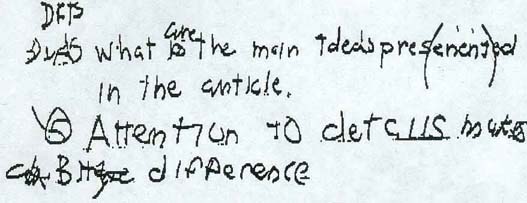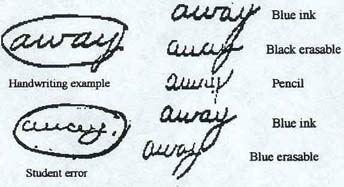IN THIS ISSUE
Happy Holidays and New Information
Facing Learning Disabilities in The Adult Years
Teaching Mathematics to Students With Learning Disabilities
Use Of Color In Handwriting and Notetaking for a Student With a Learning Difference
From Failure to Success in College
|
USE OF COLOR IN HANDWRITING AND NOTETAKING FOR A STUDENT WITH A LEARNING DIFFERENCE
Arthur was a 28 year old college graduate who had advanced through college using computers for his writing assignments. His father owned a marketing firm, but was reluctant to hire Arthur. He took so long to print or write that it interfered with his formulation of thought. Although Arthur wanted to go to graduate school, he felt that his notetaking skills were too weak.
Arthur seemed to be able to copy better if I wrote out the exercises in bright blue markers, and if he copied them in bright, cool colors (blue, purple or green) using plasticized cards with dry-erase markers. Practicing writing each syllable in a contrasting color also seemed to help. Eventually, with sufficient practice, he was able to read, copy and write in any color, and to write and formulate thought with greater ease. He began to take business classes, and was able to do his homework on a more sophisticated level in one fourth of the time it had taken him before. His spelling errors decreased, and his handwriting and printing improved, although he preferred to print. Today, he is a successful business manager for a company in Baltimore, Maryland.
These interventions may be adapted for all ages, and apply to English and foreign language studies. References Blakeslee, Sandra A. (1991) "Study Ties Dyslexia to Brain Flaw Affecting Vision and Other Senses." New York Times 15 Sept. 1.1 Foss, Jean (1991) "Nonverbal Learning Disabilities and Remedial Interventions." Annals of Dyslexia, 41, 128-139 King, Diana H. (1987) Cursive Writing Skills (right-handed). Cambridge, MA: Educators Publishing Service King, Diana H. (1987) Cursive Writing Skills (left-handed). Cambridge, MA: Educators Publishing Service Livingstone, M. and Hubel, D. (1988) "Segregation of Form, Color, Movement and Depth: Anatomy, Physiology and Perception." Science, 240, 740-749
Campbell, D. (1997) The Mozart Effect. New York, NY: Avon Books Chase, C., Rosen, G., and Sherman, G. (1996) Developmental Dyslexia: Neural,
Lyon, G. and Rumsey, J. eds. (1996) Neuroimaging: A Window to the Neurological
Masland, R.L. (1976) The Advantages of Being Dyslexic. The Annals of Dyslexia, 26, 10-18 Mercugliano, M., Power, T. and Blum, N., (2001), The Clinicians Guide to
Rawson, M. (1955), Dyslexia Over the Lifespan: Adult Accomplishments of
Sherman, G. (2000) "Dyslexia and Talent…A Connection?" Perspectives, 26, 2, 1-36 Hilda Coyne © 2003 All rights reserved |

 Arthur,
like many other students with learning differences, had difficulty
reading and copying in a full range of colors, especially connecting
letters with bridges such as "b", "o", "w",
or "v".
Arthur,
like many other students with learning differences, had difficulty
reading and copying in a full range of colors, especially connecting
letters with bridges such as "b", "o", "w",
or "v".